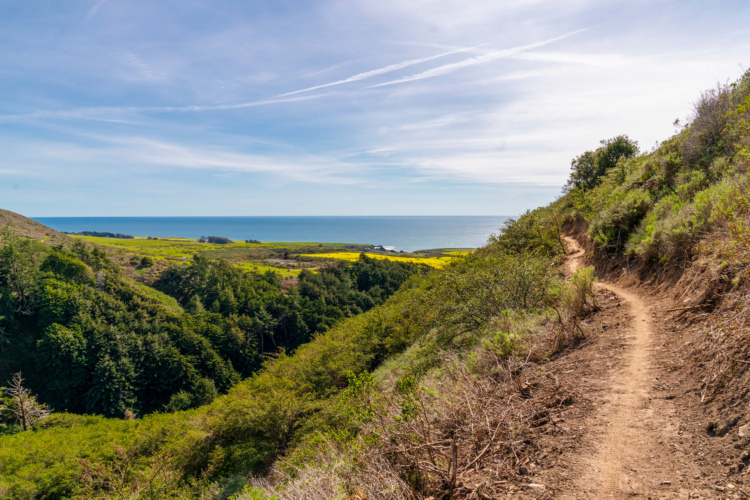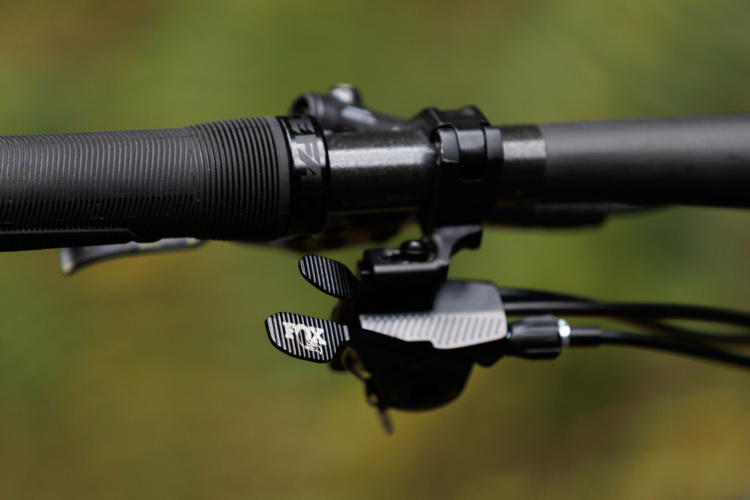The Meta AM V4 is Commencal’s bread-and-butter, 150mm rear wheel travel, 27.5″, all-mountain enduro machine. Already a mouthful of a description, I’d also like to add: bloody awesome! And before you think the next 1,479 words are going to be nothing but fluffy praise in a sustaining effort to lube the industry, I’ll cut to the chase. Did I like the bike? Yes. If I was in the market for a bike of this caliber, would I buy it? I was, and after one month of testing, I did. How’s that for a review?
The Race build I tested is the highest end option in the Meta AM full suspension line up, featuring an impressive mix of SRAM, RocSshox, e*thirteen, and Ride Alpha components, but the same triple-butted alloy frame can be found on the Meta AM V4 Origin, Essential, and Purple. Before you get down and dirty here with the final take, make sure to get up to speed with my On Review, where I crunched numbers, discussed components, and provided detailed photos.
I spent the month of September riding 242 miles and over 27 hours testing the Meta AM V4 Race in the Southwest Washington backcountry, along the banks of the Columbia River Gorge, down the Mount Hood corridor, and on Central Oregon’s finest trails. I rode the Meta V4 on everything from tight, twisty in-town loops to wide open, old school downhill. I rode up and down the steepest, loosest grades I could find, took the best and worst lines, and rode it both like a good boy should and an absolute fool. In the end, the Meta AM V4 exceeded my expectations in terms of what a 29 pound, 6-inch travel bike is capable of. Now, let’s dive into the details!
Suspension Kinematics
In 2014, Commencal introduced its Contact System, a duel-stage rocker link-driven single pivot, in an effort to reduce weight, better align compressive forces with the frame, and simplify the Meta’s design. Pivot positions are optimized for better traction, balance, and pedaling efficiency without compromising the plushness inherent to a single pivot design. I personally grow tired from reaching for knobs for every change in terrain and have become more of a set-it-and-forget-it kind of guy for which the Contact System performs admirably when leaving the shock in the open position. On that note, there’s a lot to be said about pairing Commencal’s suspension platform with the performance of the Monarch Plus RC3 Debonair equipped with a Lock/Pedal/Open lever for on-the-fly adjustment that does improve upon the Meta’s suspension behavior in certain terrain.
Climbing
Is that too much bob? Is the head angle too slack? Is the top tube too short? Am I too short? (yes). Should I stand or sit? Who am I? What’s the purpose of life? The pedal up on any new bike of this nature is a complete head game. In the enduro era, we’ve witnessed an up-cropping en masse of all-mountain rigs that are more capable in more ways, as the gap between climbing ability and descending prowess narrows.
The Meta AM V4 has 150mm of rear wheel travel, sports a 66º head angle, and comes stock with a 50mm Ride Alpha stem which, although not a winning climbing combination, surprisingly did not oppose the vast majority of my uphill battles. From fire road to singletrack, technical to smooth, and sustained to short, the Meta AM V4 ends up being a very competent climber, given its downhill lean. Outside of geometry, the overall weight of the bike (28-29 lbs with tubes and without pedals) may become a factor for some looking to cover long distances with significant climbing involved. Again, the Meta V4 is a long-travel, aluminum, all-mountain, enduro (as in no timed climbs) bike!
While I found the Monarch’s Lock mode to be unnecessary, save for the occasional paved climb, the shock’s Pedal (middle) setting made more sense on longer fire road climbs, especially with loose rock and ruts. For technical singletrack climbing, the Pedal mode was too stiff for my liking, whereas leaving the shock open offered that extra squish for excellent traction and stability when picking my way up and over rocks and roots. It was only on those occasional very steep, punchy sections of singletrack that I found my rear over the nose of the saddle and hunched over the bars to prevent a slight tendency of the front end to wander. If you simply cannot muster this little bit of body english, the Meta’s top tube length allows plenty of room for a longer stem.
Descending
When it came time to flop the front wheel up and over, pointing the Meta AM V4 back from whence I came, the head games came to an abrupt end. During the first couple of turns and small drops, I was taken over with a clarity louder than the rushing undercurrent of rock and root — This. Bike. Rips! Equipped with the Rockshox Pike and Monarch Plus, in concert with Commencal’s pivot platform, the Meta AM V4 descends freakishly well, and the term “confidence inspiring” never made more sense.
Drops, jumps, scree, and steeps larger and longer than I was comfortable with became smaller, smoother, and easier to handle. The Meta V4 is very comfortable in wide open terrain, no matter the degree of technicality, and max speeds of 40 mph popping up on my Strava became commonplace. And make not the mistake that the all-out intrepid descending power of the Meta somehow compromises its maneuverability in tight and twisty stuff. Descending Hardesty and Lawler demands unwavering focus and surgical precision as you drop through some of the narrowest, gnarliest, steepest lines in Oakridge, OR, which the Meta handled impeccably.
Everything In Between
Provided you’ve spent some time dialing in the Pike RCT3 and Monarch Plus (and why wouldn’t you), the Meta V4 offers two noticeably distinct feels. Through undulating trail mixed with short climbs and descents, the Meta works well with the shock in Open or Pedal mode, and the choice simply comes down to what you want out of the bike. In Open, the Meta feels more like a Cadillac, diving deep into its travel through corners where traction and stability are a must, at the expense of more rider input when pumping and accelerating.
Flipping to Pedal mode reliably toned up the feel, making the Meta more sprightly and sporty, allowing me to pump with less effort, pop out of corners more quickly, and accelerate more efficiently. That a suspension’s damping controls will predictably firm up the ride may go without saying, but it’s this characteristic that makes the Commencal’s modified single pivot on the Meta so fun. You’ve the ability to take advantage of its full plushness or utilize shock adjustments to significantly change the bike’s performance–a quality that is often lost in fancier, proprietary suspension platforms.
As for bob, squat, and kickback, there is somewhat of a trade off, but only because the laws of physics demand such a compromise (on any bike). While it’s difficult to tease these forces out, I’ve surmised what little bob I felt must contribute to a pedal kickback-free ride, and the Monarch Plus’s Rapid Recovery provides efficient pedaling at the sag position.
Components
SRAM drivetrain: equipped with an X1 shifter and X01 rear derailleur, the Meta V4 Race shifted smoothly, quietly, and without fail.
SRAM Guide RS brakes: as a Shimano man myself, SRAM Guide was a pleasant surprise. While the overall stopping power goes to Shimano, SRAM Guide gets the nod for modulation–a trade off I’m happy with.
e*thirteen TRS+ cranks and wheelset: the e*thirteen cranks were flawless under the rigors of my test, but the wheels had me scratching my head a bit. The enduro-built hoops were stable and stiff when plowing straight lines at speed, but seemed flexy under certain cornering conditions. I’m not completely convinced, however, that the e*thirteens are completely at fault, as they were sent with Maxxis Minion DHR II tires (of which i’m not a fan), and were tested on Bend’s brake bump-infested, blown out corners.
Ride Alpha stem and bars: the cockpit bits from Commencal’s in-house brand was the biggest surprise of the component check. The 50mm stem and 780mm bar pairing hit a sweet spot for me, and I see no reason to replace them.
RockShox Reverb Stealth: while the dropping action of the Reverb Stealth seems overtly tight and no where near as smooth as my own KS LEV Integra, the damn thing pops up on cue without any rear end coaxing–an inherent issue with the KS.
Summary
The Meta AM V4 certainly goes down better than it climbs, yet the margin is as narrow as any current enduro bike with similar geometry and travel. Commencal’s Contact System platform, along with innovative Rochshox technology, provides both plushness and performance in the most demanding terrain, and its point-and-shoot attitude does not override the ability to throw the Meta around through the tightest and trickiest of trail. The Meta AM V4 is for those who like to “enjoy” climbs (not race them), crush descents (not pussyfoot them), couldn’t care less about the carbon craze, and like a little cash leftover for the shuttle, post-ride libations, upgrades, scratch-and-win tickets, cinnamon bears, or whatever pings your pong.
Available direct from Commencal USA, the Meta AM V4 Race is $3,799, the Purple (a must-see) is $3,199, the Essential is $2,999, and the Origin is $2,199.
Thank you, Commencal, for providing the Meta AM V4 Race for review.




























1 Comments
Oct 24, 2015